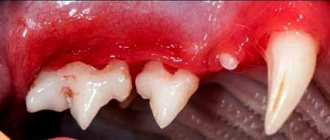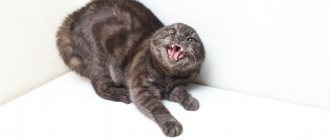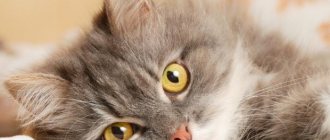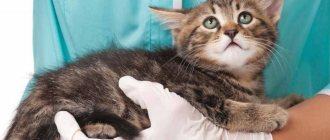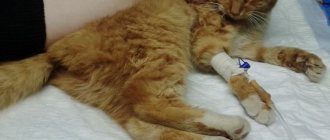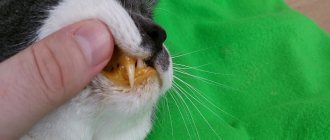Causes
Renal failure is understood as a syndrome that occurs against the background of concomitant diseases affecting the genitourinary system. Such diseases include nephrosis, pyelonephritis, urolithiasis and other kidney pathologies. Kidney failure can develop as a complication of diabetes mellitus, pneumonia, vasculitis, leptospirosis, etc.
There are often cases when a cat’s genitourinary system suffers due to poisoning with toxic substances, which occurs, for example, as a result of long-term use of medications. The load on the kidneys increases, as they try to fulfill their direct responsibility as quickly as possible - to remove poison from the body. This can lead to serious consequences, including organ destruction.
Finally, a factor that provokes kidney failure may be your furry's genetic predisposition to certain diseases, for example, polycystic disease, glomerulonephritis.
Renal failure is characterized by two forms of the disease: acute and chronic.
Acute failure is the most dangerous, as in most cases it ends in death. It proceeds rapidly and has a pronounced clinical picture. ARF, in turn, also occurs in three forms: prerenal, renal, postrenal.
Veterinarians say that the most serious form is renal. Regarding prerenal and postrenal, the prognosis is rather favorable.
In chronic renal failure, the kidneys gradually cease to perform excretory functions. For a long time, chronic renal failure may not manifest itself at all. This is why she is dangerous. Kidney cells die gradually, the load is redistributed between healthy cells, but then they die.
Damaged tissues become scarred, causing the kidneys to decrease in size and no longer cope with their duties. As a rule, chronic renal failure is diagnosed in older cats.
CRF has four stages: latent, initial, conservative, terminal.
The latent form has the greatest chance of a favorable outcome, but timely diagnosis occurs in the rarest cases. In case of terminal illness, unfortunately, it is no longer possible to help the animal, so the only way to stop the pet’s suffering is euthanasia.
Why is an organ so important to an animal?
Kidney failure is a condition in which the kidneys fail to flush out toxins from the body and lead to fluid imbalance.
The disease manifests itself with kidney damage up to 80%. Urine becomes almost colorless, which indicates that it does not remove toxic substances from the body. Representing a paired organ, the kidneys carry out the work of purifying the blood. Healthy organs contribute to the elimination of metabolic products and toxic substances formed in the body of carnivores. The kidneys are also involved in hematopoiesis. Therefore, nephrological diseases are accompanied by severe intoxication of the animal, disturbances in electrolyte, water and protein metabolism and are the cause of death in 20% of furry pets.
It is believed that domestic cats are susceptible to kidney pathology due to genetic predisposition. In addition, cats have a long but narrow urinary canal, which often contributes to blockage and inflammation. This especially affects cats, whose urinary system is even narrower than that of females.
Symptoms
If we are not talking about an acute form of renal failure, then for a long period the pathology occurs in a latent form. Gradually the cells die, but the kidneys continue to work. Characteristic signs of renal failure appear when the volume of damaged tissue is more than 70%.
A cheerful and active pet becomes lethargic, sleepy, gets tired quickly and lies down most of the time. His appetite disappears, and his thirst, on the contrary, increases. Despite drinking a lot of water, the cat rarely goes to the toilet. Even if he manages to pee, the amount of urine is insignificant. The owner notices that the fluffy is constantly licking the genitals.
Then there are digestive disorders - nausea, diarrhea, constipation.
The appearance of a sharp unpleasant odor from the body and mouth of a four-legged pet is typical.
In severe cases, the animal experiences epileptic seizures, convulsions, fever, hypertension, which results in rupture of blood vessels in the eyeball and loss of vision. Intoxication of the body increases, the cat’s condition rapidly deteriorates. The kidneys do not work, causing the pet to fall into a coma and die.
Types of kidney failure
— acute — with acute renal failure it is possible to restore kidney function;
- chronic - kidney tissue degenerates into connective tissue. The process is irreversible; the kidneys do not restore function.
- to renal. The cause of kidney dysfunction is impaired blood supply due to severe dehydration or prolonged exposure to anesthesia.
- after renal. It occurs against the background of an abnormal outflow of urine caused by urolithiasis (blockage of the urinary tract).
- actual renal failure. Occurs after poisoning with a toxic substance and is a consequence of chronic diseases (in particular, chronic kidney inflammation).
Diagnostics
Diagnosing renal failure is associated with certain difficulties. It can be carried out qualitatively only in a hospital, using instrumental and laboratory methods.
First of all, blood biochemistry is carried out. The study allows you to find out the level of phosphorus, potassium, creatinine, and urea.
A lot of information can be obtained from a laboratory urine test, in particular, it indicates a change in the composition of the biological fluid, determines the level of leukocytes, the presence of bacteria and renal epithelium. The urine of a sick cat is dark or, conversely, too light and has low density. The content of red blood cells and protein is increased.
An ultrasound of the kidneys is required. It shows the structure of the organ, its location and shape, and the presence of cysts.
To determine the area of kidney damage, radiography with a contrast agent is performed.
The most accurate information is provided by computed tomography of the kidneys. But due to its high cost, it is used in rare cases.
Surgery for urolithiasis in cats
The operation on a cat lasts 40 minutes, it is performed under general or epidural anesthesia and includes the following steps:
- ultrasound or x-ray examination, which helps determine the size, number and location of stones;
- cleansing the urethra (the urethra is washed with saline);
- catheterization of the bladder (necessary to return stones and sand to the bladder cavity);
- castration (helps eliminate hormonal imbalances);
- providing access to the bladder (an incision is made in the abdominal area and on the wall of the bladder);
- cleaning the cavity from stones and sand;
- urethrostomy (during this stage, the wide part of the urethra is sutured to the skin);
- removal of the penis.
After urethrostomy is performed, a catheter is installed in cats, through which the animal urinates throughout the day. Liver treatments, antibiotics and analgesics are prescribed. The cat is discharged from the clinic 24 hours after the intervention. However, if the condition worsens, inpatient treatment is extended.
Indications and contraindications for surgery
Indications for surgical intervention for urolithiasis are:
- deformation of the urethra;
- acute urine retention;
- ineffectiveness of bladder catheterization.
Surgical treatment of urolithiasis is contraindicated in:
- acute respiratory, cardiac or liver failure;
- cerebrovascular accidents and other diseases of the nervous system;
- severe dehydration of the body;
- late stages of cancer.
Possible complications
Cats after surgery are susceptible to the following pathologies:
- bleeding (not life-threatening and does not require repeated intervention);
- anuria (cessation of urine accumulation, which is observed in the first 2 days);
- acute renal failure (requires drug treatment);
- narrowing of the urethra (the external opening becomes overgrown, the complication is eliminated surgically);
- dysuria (impaired urination);
- cystitis (inflammation of the mucous membranes of the bladder);
- urinary incontinence.
Treatment
Kidney failure is one of the incurable pathologies. However, with the help of a well-designed treatment regimen, it is possible to maintain the animal’s quality of life and achieve some improvement in kidney function.
The cat will be under the supervision of a veterinarian for life and will undergo regular examinations, including urine and blood tests. In addition, the animal will have to follow a therapeutic diet and take certain medications for the rest of its life.
Treatment depends on the form of renal failure, the general condition and age of the animal.
The acute form is treated according to a regimen that includes:
- elimination of the factor that provoked the deficiency;
- restoration of water balance;
- hemodialysis (artificial blood purification);
- removal of intoxication;
- decreased blood pressure;
- special medical nutrition.
In case of chronic insufficiency, therapeutic measures are aimed at restoring the acid-base, water-salt balance, and stabilizing blood pressure. Elimination of signs of anemia. It is necessary to undergo hemodialysis and use a strict but nutritious and balanced diet.
To improve immunity, it is advisable to use vitamin and mineral complexes.
Preventing the occurrence of disease
Kidney dysfunction can be prevented by following these recommendations:
- conduct an examination of adult healthy cats once a year, and if any disease was previously identified - once every 6 months;
- promptly treat infectious diseases of the genitourinary system, polycystic disease, diabetes mellitus;
- castrate or sterilize the animal if there are indications for this;
- do not prescribe medications on your own, seek help from a veterinarian;
- avoid injury and poisoning;
- provide quality nutrition;
- do not overfeed the animal.
When a diagnosis of chronic renal failure with severe kidney damage is made, the prognosis for a cat’s life is 2-3 years with quality nutrition and good care.
What to do at home
The owner must strictly follow the veterinarian's instructions. Self-medication and replacement of traditional methods of conservative treatment lead to detrimental consequences.
A sick pet needs to be provided with quality care and therapeutic nutrition. The diet lasts for at least six months. At this time, salt, sea fish, fatty meats, offal, cereals, and dairy products are completely excluded from the cat's menu. Flour products and fish oil are prohibited.
The diet consists of poultry (chicken, turkey), broth, vegetables (cabbage, carrots). There are few acceptable products, so veterinarians recommend giving preference to special medicinal dry food.
A product from Royal Canin, Renal food, developed for cats with renal failure, received high marks from experts. It includes all the vitamins and nutrients your cat needs during intensive care.
Possible diets and pet maintenance
A sick animal should consume less protein and phosphorus. The minimum period of diet therapy is 6 months. If 75% of the nephrons are damaged, it is prescribed for life.
The following foods should not be given to your cat:
- dairy;
- salty;
- fish, fish oil and caviar;
- fat meat.
Phosphorus intake should be reduced to 65-85 mg per 1 kg of cat weight. The development of uremia causes an increase in the content of phosphorus in the blood, and if its intake into the body through food is not limited, a large amount of the element will not only complicate the course of the disease, but will also negatively affect the bones and central nervous system.
The diet should include:
- carrot;
- cabbage;
- rabbit, chicken or turkey meat.
It is allowed to include liver and chicken hearts in the menu 2-3 times a week. Meat can be given raw, but before that it should be kept in the freezer for several days to destroy harmful microorganisms. It is important that the daily protein intake does not exceed 4.5 g per kg of body weight.
If the analysis shows a urea level of 30 mmol/l, a protein-free diet is prescribed: pasta with vegetable oil, oat pancakes, bread. Food can be sweetened.
A cat suffering from kidney failure should always have access to fresh drinking water in the amount its body requires. Meals are prescribed in fractional amounts - 4 times a day in small portions. If you have PN syndrome, you should not fast. If the animal refuses to eat, do the following:
- palm fed;
- heat food to stimulate appetite with a strong smell;
- food is administered through a syringe (without a needle).
The syringe can be filled with a mixture of 100 ml water, 100 ml milk, 1 tbsp. l. sugar and 1 tsp. potato starch. Everything needs to be mixed, boiled, cooled, then added the crushed Mezim tablet and 1 egg. If the cat is vomiting, give 5 ml of the mixture once an hour. If there is no vomiting, feed less frequently, but increase the portions.
Veterinarians recommend purchasing special food designed for cats with kidney dysfunction during intensive therapy (for example, Royal Canin Renal, Farmina Vet Life Renal, etc.). Finished products support the health of cats, prevent the formation of calcium oxalate stones in the kidneys and the recurrence of urolithiasis. They contain:
- reduced amount of protein (up to 32%) and phosphorus (up to 0.5%);
- vitamins;
- polyunsaturated fatty acids;
- antioxidants with synergistic action.
You can buy a dry product (in the form of crickets), and for cats suffering from gingivitis, a wet product (in the form of a mousse). The daily dosage in grams is indicated on the packaging.
A cat with chronic renal failure should not be allowed to walk on its own. It is protected from infection and injury. You should not touch the cat's belly - this causes pain and aggravates the disease. It is necessary to provide her with a quiet place to rest.



